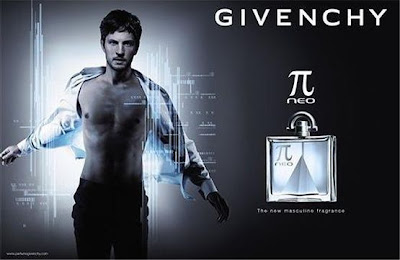Back to the Future: Givenchy Pi Neo
 I'm a little annoyed at myself for never having written about Givenchy's Pi (except in passing), because it would be a lot easier to talk about their newest men's offering, Pi Neo, by comparing it to the original. I'll just have to do it backwards, then, without any reference to the original, and get to Pi one of these days.
I'm a little annoyed at myself for never having written about Givenchy's Pi (except in passing), because it would be a lot easier to talk about their newest men's offering, Pi Neo, by comparing it to the original. I'll just have to do it backwards, then, without any reference to the original, and get to Pi one of these days.Pi Neo is a very silly name for a fragrance, for two reasons. First, the "Neo" part of it is an explicit reference to "The Matrix", and if you want to seem modern, even futuristic, what better way than by naming your scent after a character in a movie that's almost a decade old? Second, "Pi Neo" sounds as if it should be a floor cleaner with a cartoon character for a spokesperson: "Piney-O!"
 The bottle's nice and modern, though, a sort of chimeric square/triangle object, reassuringly solid in the hand, with the same omega-capped sprayer as the original, but in frosted silver instead of bronze. (The omega pivots to protect or free the spraying mechanism; it doesn't really do much to keep the sprayer from accidentally discharging in your luggage, but it looks good.)
The bottle's nice and modern, though, a sort of chimeric square/triangle object, reassuringly solid in the hand, with the same omega-capped sprayer as the original, but in frosted silver instead of bronze. (The omega pivots to protect or free the spraying mechanism; it doesn't really do much to keep the sprayer from accidentally discharging in your luggage, but it looks good.)The marketers are making the scent sound as forward-thinking as possible by bragging about the synthetics used in its composition, too. The sample packaging (a dribbly, annoying 1-mL foil envelope) says the scent family is "fusing woody" (more silliness) and consists of "Toscanol--aniseeed flash, Cedarwood fraction Texas, Patchouli fraction Indonesia, Vanillian extracted from Benzoin Siam", which makes it sound like something that came out of an oil refinery. The promotional material mentions the synthetics Toscanol, Safraleine, and Cosmone, which sound like nothing on Earth.
Okay, that's out of the way. What does it smell like? Pretty good, surprisingly.
The top note does contain that promised "aniseed flash" tucked into a gas flare of citrus (bergamot and mandarin, say the listed notes). But if you're expecting something typically fresh-ozonic from the blue of the juice, you've been misled, as I was, because lurking underneath is a mostly oriental scent, or, more accurately, a sort of hybrid fresh/oriental scent: a trace of freshness lasts right through the expiration of the scent on the skin, and that's a long way away. (I could still smell it, close up, twelve hours after I put it on, and that was after a workout and a shower.)
The body of the scent is warm and cozy with a slightly metallic undertone. The synethic odorant Safraleine is supposed to "[exhibit] warm, powerful, leathery and tobacco facets but its complexity also reveals characteristics of spices reminiscent of natural saffron, enriched by rose ketone-like floral aspects": good luck finding all that in there. It doesn't smell like saffron, at least not at this concentration, and in fact it doesn't smell like anything I can put my finger on, not roses, not leather or tobacco; it mostly smells indefinably warm and woody, and that's not a bad thing to smell like.
There's already a typical vanilla-amber undertone to the middle (although much less sweet than usual, because it's cut through by the light but persistent synthetic-metallic-fresh aspect), underscoring the warmth, and that only increases as the scent begins its descent into the base notes. The patchouli isn't strong: you'd never call this a patchouli scent. You'd also never call Pi Neo wildly original or a must-have, but over the course of its life on the skin it's better, certainly more interesting, than most mass-market scents out there.













